INTERACTIVITY - MUSEUM - R&D
Jul 27, 2020Advocacy for inclusive museums after Covid-19
Some museums are still in lockdown, other are now reopening their physical site to the public, all have to wrestle with the complexity of this new situation.
This synthesis from Tactile Studio Webinar, breaks down the challenges, solutions and innovations to discover how museum professionals and institutions sustain their educational mission and commitment towards accessibility, equity and inclusion, around the world.
THE WEBINAR IN A FEW FIGURES
🌍 15 countries:
Belgium, Brazil, Canada, England, France, Germany, Ireland, Lithuania, Malaisia, Netherlands, Romania, Russia, Spain, Switzerland, United States.
🙏 More than 150 participants.
🎯 3 main topics:
Challenges, Solutions and Innovations.
🎤 4 international speakers:
Argentina: Museo de Arte Moderno de Buenos Aires, Patricia Riguera, Head of Education Department,
Canada: National Museum of Fine Arts of Quebec, Josée Duhaime, Director of mediation and visitor experience,
Germany: Klassik Stiftung Weimar, Regina Cosenza, Head of Bauhaus Agent, Project Manager,
France: Tactile Studio, Philippe Moreau, CEO and Founder.
🗣 1 animator:
Aurélia Fleury, Tactile Studio Canada Director.
💻 3 community moderators:
Alexandra Verdeil, Tactile Studio Germany and Austria Director,
Marie Clapot, Tactile Studio Consultant and MET Professional,
Joan Raymond, Tactile Studio Community Manager.
MAIN SHARED CHALLENGES
– Establishing museum hygiene, safety and accessibility protocol for reopening.
– Maintaining contact with audiences, communities and partners.
– Keeping accessibility program during lockdown and re-opening.
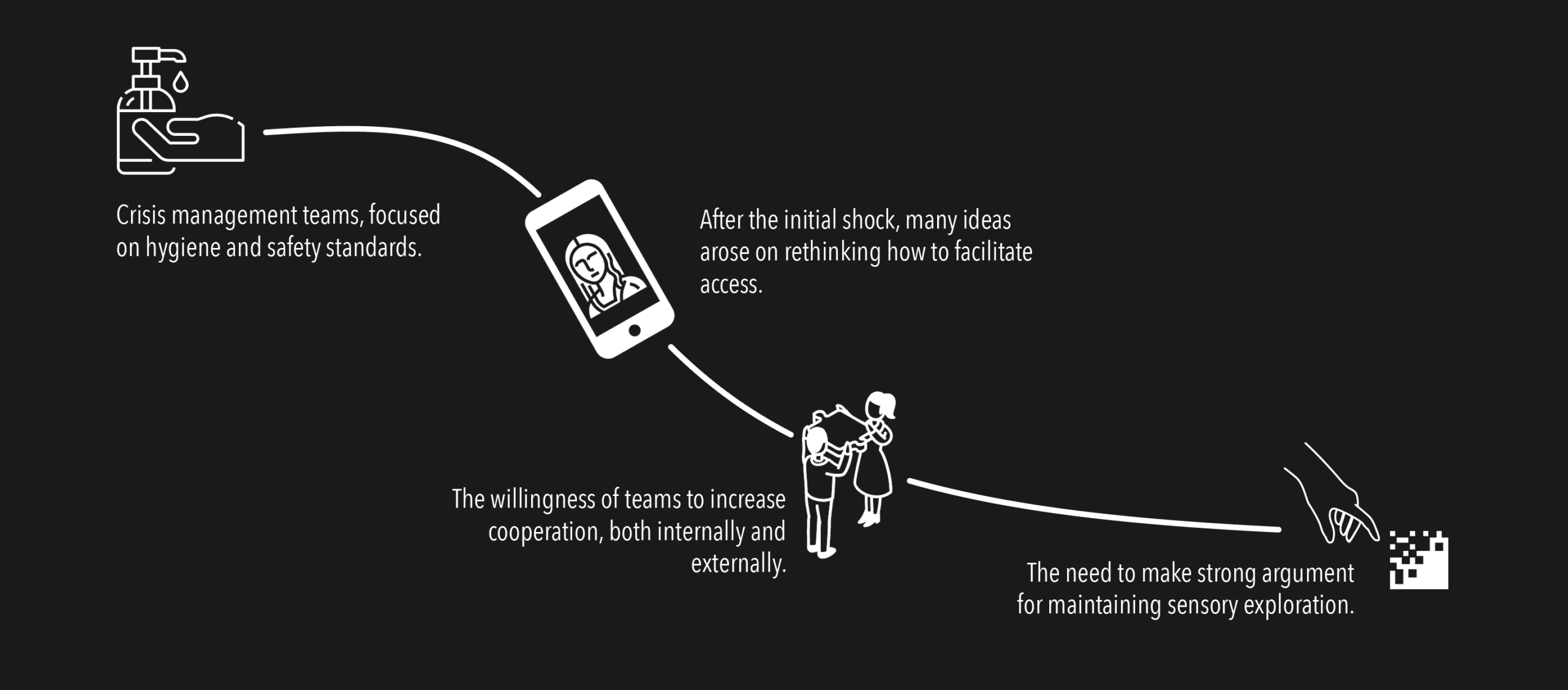
SOLUTIONS AND INNOVATIONS
🍃 Creating safe environment:
– Using immersive design to play with this new constraints:
“We are working with local artists, we have created a terrace with umbrellas, tables and chairs and easy access to all kinds of visitors. And we have developed a cultural program where all activities are held outside. We have developed a walk around the pavilions accessible for all wheelchairs family, children, senior citizens.” – Josée Duhaime, National Museum of Fine Art Quebec, Canada
🧼 Hygienic tools:
– Safe (by Tactile Studio), an ergonomic hand-sanitiser dispenser adapted to all devices.
– Clean (by Tactile Studio), a cleaning kit for tactile stations and objects.
Tactile Studio cleaning instructions for tactile stations:
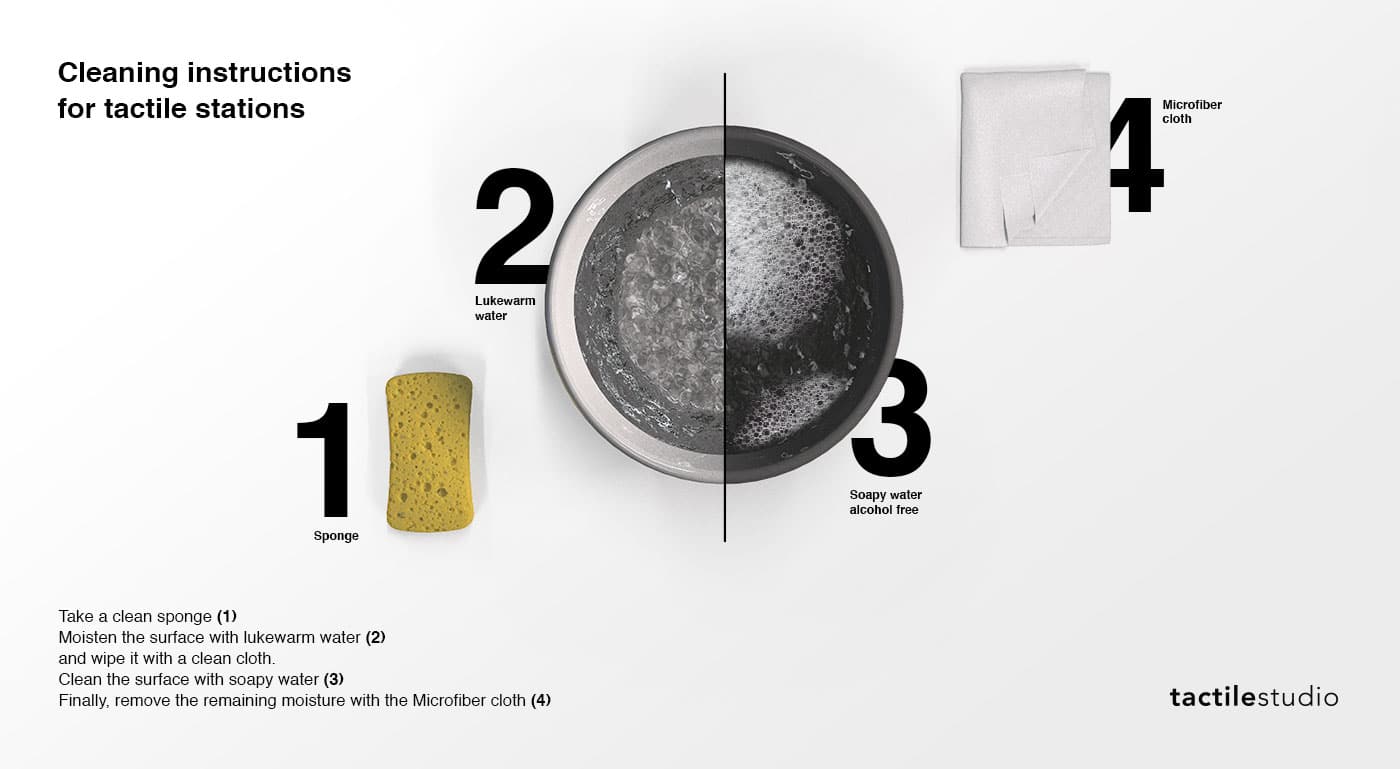
– Fingertip protection:
“We recently gave fingertips to visitors to touch the tactile exhibits, combined together with audio description and easy language the App Bauhaus+.” – Regina Cosenza, Klassik Stiftung Weimar
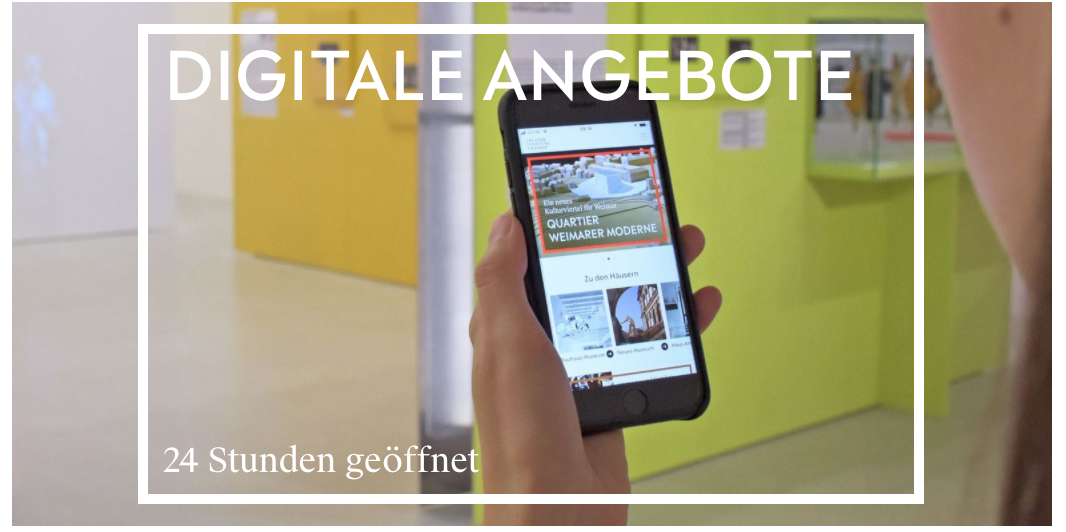
📖 Reinventing inclusive and accessible educational programs:
Online
– Reinventing curation during lockdown:
“We have gathered a team of curators, educators, editorial department, exhibition department and communication department, we meet twice a week. And we create a two week theme, where we invite local artists. People are talking about important subjects in our community. We decided that this strategy will also help them to continue their own art projects and give them visibility and showing their ideas and thoughts. This also involved all our education programs. We had artists doing special illustrations and videos for the Education Department.” – Patricia Rigueira, Museo de Arte Moderno, Buenos Aires, Argentina
More resources: Art Education innovations l www.aprendoencasa.org (in Spanish)
– Sharing cultural material online with other institutions:
“During this three, four months that we’ve been in lockdown we had around 4.300,000 views on our website and social medias and around 12,000 downloads in our education section. Most of our materials are in the Ministry of Education website and the Ministry of Culture as well, and we have partnered with some international organizations.” – Patricia Rigueira, Museo de Arte Moderno, Buenos Aires, Argentina

– Sharing cultural material online with audiences:
“We broadcast a 2-minute digital workshop on Instagram and Facebook every Friday with a new challenge and new materials, that the audience has at home. The educators can speak to the audience online and we also provide an English description, so that it can be seen internationally.” – Regina Cosenza, Klassik Stiftung Weimar
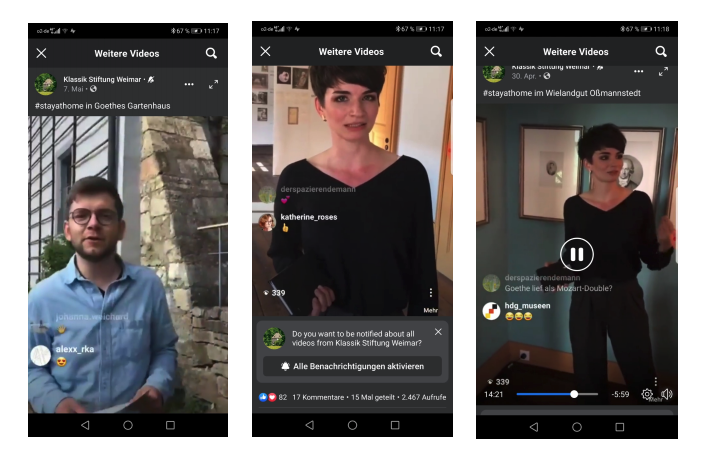
– Combining digital and analog material:
“We sent to kids 30 pedagogical boxes with workshop material. They were able to follow Youtube videos and to communicate online with our educators, ask questions and share their results.” – Regina Cosenza, Klassik Stiftung Weimar
Museum In situ
– Allowing specific time slots for groups with special needs:
“So we decided to also open early mornings (Frida Kahlo temporary exhibition) on Tuesday and also offer any other time if we are told ahead of time. On the regular time before COVID, Frida Kahlo, our actual exhibits, would help 200 people per hour, COVID time is 80. And for any community organization having special needs, we also brought it down to 40 people an hour.” – Josée Duhaime, National Museum of Fine Art Quebec, Canada

– Exploring new spaces for curation:
“We develop new programs, like a dancing tour at the garden of sculptures, where dancers use the sculptures to inspire their movements, and also yoga sessions where the visitors get inspired by the artworks around. We also offer all of our activities outside for them (people with different abilities) differently organized and arranged so that they can actually be having an offer through the summer.” – Josée Duhaime, National Museum of Fine Art Quebec, Canada
In conclusion:
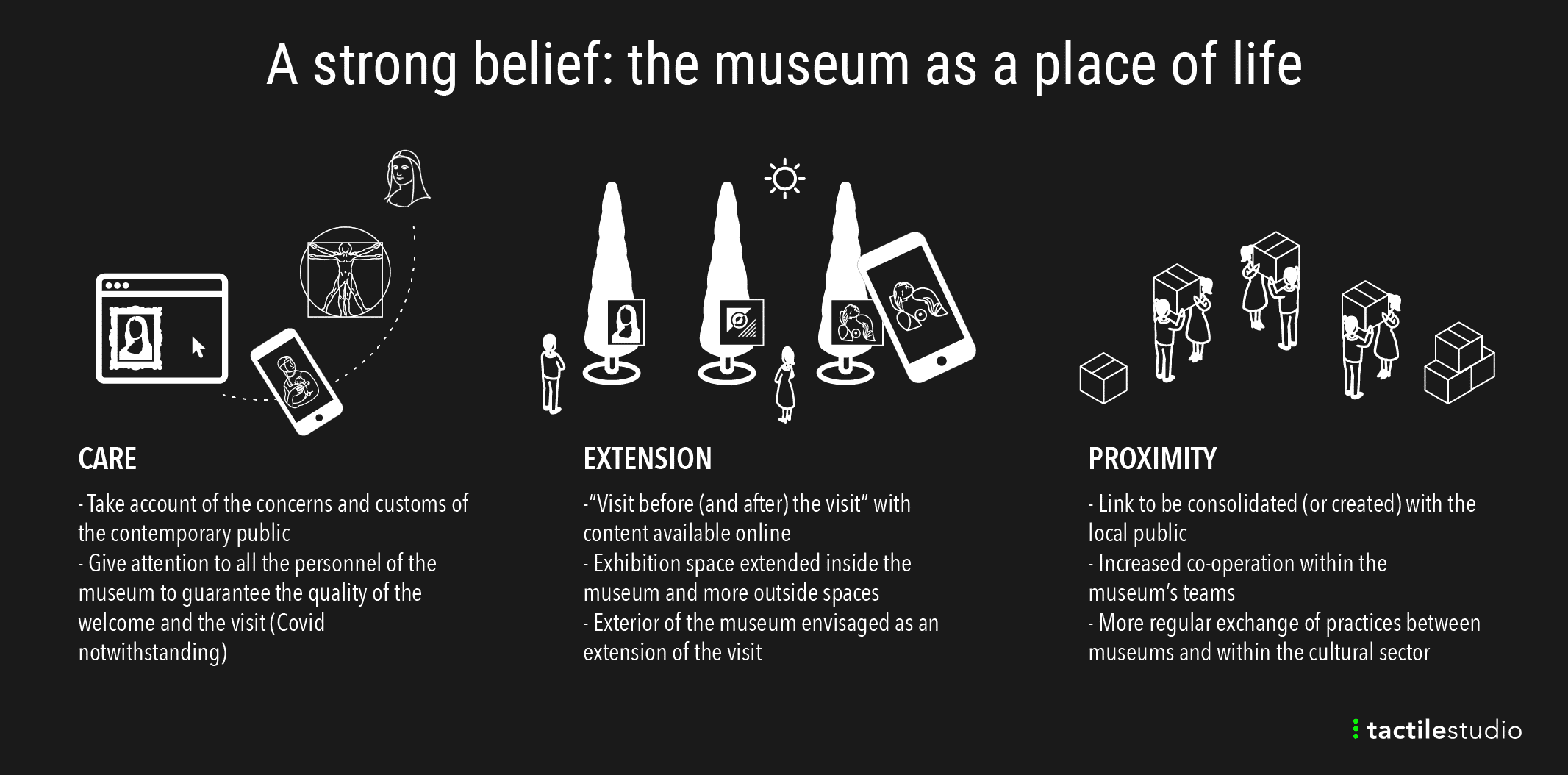
Q&A AND RESOURCES
🤚 Touching at the museum in COVID time:
“In age of the “nothing about us without us” movement, where do the presenters getting their expertise on various disabilities and how to mitigate them in museum settings? I have not heard about any consultation with the disabled people who are ultimately affected by what museums do, right or wrong.” From Christine Switzer
Presenters work in the field of museums and accessibility (head of the educational service, head of visitor experiences). Their work is focused on welcoming visitors and groups of all kinds. They develop specific programs for DEAI (Diversity Equity Accessibility and Inclusion) groups, in collaboration with users, communities and partners. Additionally, Tactile Studio frequently conducts usability testing and co-design on prototype with groups of blind and visually impaired users.
To read about Visually impaired reality in time of COVID, discover the links below:
– Coronavirus: Social distancing for the visually impaired in Italy
“Museums are open again but with few visitors & restrictions. We see that everything what can be touched or is interactive is closed or hidden now. This is the most interesting for blind people; so they stay home; afraid? What is your experience on this? How TACTILE is the museum of the future? Thank you for this interesting initiative.” From Bart Vermandere
Cleaning and disinfecting public spaces during COVID-19 help people to feel safer. It is important to consider when cleaning takes place – consider moving cleaning to the day, so visitors see this activity to build their assurance that your site is safe. Shifting cleaning and sanitation from an “after hours” chore to something conducted during operational hours both ensures the enhanced cleanliness of your site and reassures visitors throughout the day. Cleaning protocols will be the backbone of most reopening plans. These protocols could include: How often should different surfaces be cleaned. The World Health Organization notes that the COVID-19 virus can live on different surfaces for different amounts of time. Studies have suggested that the COVID-19 virus can survive for up to 72 hours on plastic and stainless steel, less than 4 hours on copper and less than 24 hours on cardboard. The frequency with which you will need to clean exhibition space and tools will depend on material and use.
Resources:
– Cleaning and disinfecting public spaces during COVID-19
– COVID-19 Resources for Museums and Cultural Organizations
– Reopening Guidelines for BC Museums, Galleries & Cultural Organizations
← ↑ Signage & Communication:
“Could you explain how the safe placemaking is accessible for short sighted?.” From Severine Kas
Good design means everyone benefits. People who use your building or facility may be blind, low-vision or deafblind. This means the only way they can access the vital information conveyed by building signage is by touch or by high contrast and clear print. We therefore recommend creating signage respecting contrast (texture, colors), accessible lay-out (size, using pictograms), you also may use sounds, in order to make it the most accessible. Depending on your project you can work with a designer in order to creatively answer the challenge the project raises.
You may be interested in downloading this pdf guideline.
Great tool for accessible design: Download pdf. It is a practical Handbook on Accessible Graphic Design, Made by The Association of Registered Graphic Designers of Toronto.
And a more specific guideline from Literacy Braille Canada about accessible signage will help you ensure the signage in your building or facility is readable to all who use it, including blind, deafblind and low-vision people.
“What does the panel recommend for those who are medically high risk? Especially those in hospitals?.” From Lindsey Flax
Adapting programs for digital platform and creating online tools can help. As the program from the Modern Art Museum of Buenos Aires with the creation of monthly ressources to download (meditations, podcasts and workshops).
📒 International networks for good pratices:
“Each museum has its specific issues, but access and social justice is common. So are there well-developed lines of cooperation and communication to share good practice and innovative ideas?.” From Virman Man
There are indeed museum networks providing advices and tips and connecting museum professionals together around the main topic of inclusion in museum:
– The Inclusive Museum Research Network
– The IHCD and the Smithsonian Institution
– Tactile Studio published in cooperation with MUXXE an international report on museum practices after the lockdown
Available in four languages: French / English / German / Spanish
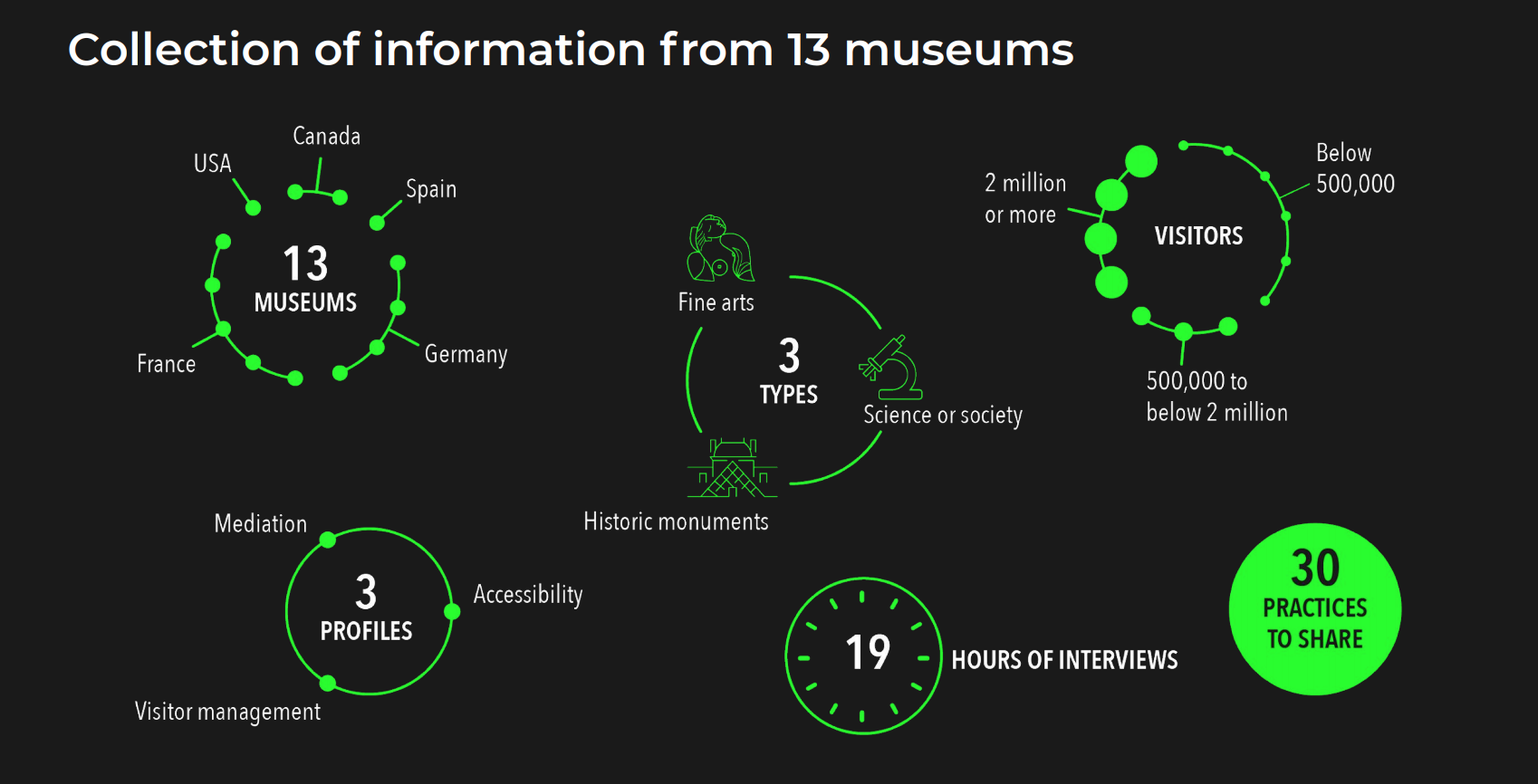
Thank you for reading!
We are looking forward to having you in another Tactile Studio Webinar.

Sorry, the comment form is closed at this time.